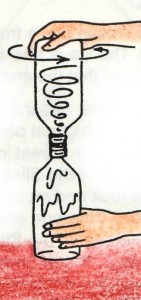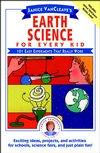
In the world around us there are many examples of vortexes: tornadoes, whirlpools in a sink or tub, swirling vortexes in rivers and oceans and, of course, hurricanes. You can make your own vortex to do experiments with. For this you will need two empty plastic soda bottles (with the labels removed), duct tape, and a metal washer with a hole in its center. The washer should have the same circumference as the mouth of the bottle. duct tape.
Fill one of the bottles about 2/3 full with water. Dry the mouth of this bottle, then place the washer over the mouth of the bottle. Place the second bottle upside down on top of the washer. Secure the bottles together with tape.
Turn the bottles upside down so that the bottle with water is on top. Stand the bottles on a table. Place one hand around the lower bottle and the other hand on top of the upper bottle. Support the lower bottle while quickly rotating the upper bottle several times in small counterclockwise circles. Stand the bottles upright, with the empty bottle on bottom. Observe the movement of the water inside the bottles.
What Happens?
The water swirls in a counterclockwise direction, forming a funnel shape as it pours into the lower bottle.
Why?
The funnel formed by the swirling water is called a vortex (a whirling fluid in the shape of a funnel). The vortex formed in the water is the same shape as the vortex formed by a tornado (a violently rotating funnel cloud that touches the ground). A tornado looks like a swirling funnel hanging down from a dark thundercloud. Note: Tornadoes are only visible if they contain visible particles, such as dust.
Simple Ideas Can Be Science Projects
Science experiments that make learning about our Earth fun as well as informative.
(Paid Link)
